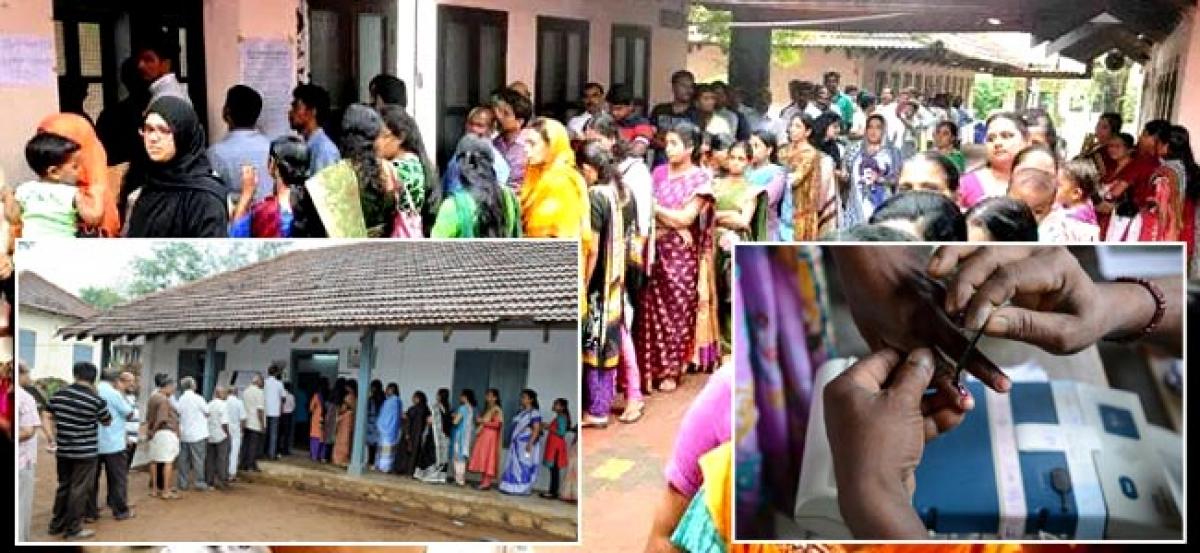Live
- Jana Sena MLA Pulaparthi Ramanjaneyulu Elected as PAC chairman
- Stage set for counting of votes for Jharkhand Assembly elections
- MLA Sri Ganesh Engages ASHA Workers and Resource Persons in Caste Census Meeting
- Supreme Court verdict on validity of Preamble modification in 1976 likely on November 25
- ‘Zebra’ movie review: A gripping tale of banking fraud and redemption
- Saurabh Netravalkar, Unmukt Chand, Dwayne Smith and Rahkeem Cornwall headline USPL
- NPP asks members not to attend meeting called by Biren govt
- Bulls roar on Dalal Street, Sensex and Nifty up over 2 pc
- Over 880,000 people displaced in Lebanon, food security deteriorates: UN
- BGT 2024-25: Bumrah picks 4-17 as Australia trail India by 83 runs in 17-wicket day
Just In

Over 20 years and five assembly elections -- as women became better educated, led a variety of popular movements, voted in and contested elections in ever greater numbers in Kerala
Over 20 years and five assembly elections -- as women became better educated, led a variety of popular movements, voted in and contested elections in ever greater numbers in Kerala -- the number of directly elected female legislators has steadily declined, according to an IndiaSpend analysis of electoral data.
The percentage of female members of the legislative assembly (MLAs) fell from 10.23 per cent in 1996 to 6.06 per cent in 2016, even as the number of women candidates doubled over these five elections.
In an overwhelmingly male-dominated country, this statistic from Kerala's 2016 assembly elections appeared remarkable: 105 women contested -- a third as independents, indicating a determination to go it alone -- up from 83 in 2011.
As the Left Democratic Front returned to power after five years, no more than eight women were elected in a 140-member house, which means Kerala has just one more female MLA than in 2011.
The lack of success clearly is not for want of trying. But success does not appear to be correlated with the growing number of women turning out to vote. As many as 78 per cent women voted in the 2016 election, up from 75 per cent in 2011. The male polling percentage in 2016 was 76 per cent.
The data appears to suggest that although women are contesting and voting in record numbers, they are not voting for other women.
Even if more female MLAs were elected, that may not be enough to alter gender equations, experts said.
“Merely increasing the number of women representatives will not ensure a qualitative change towards gender inclusion,” said Binitha Thampi, Professor of Development Studies in the Department of Humanities and Social Sciences at IIT-Madras. “It is time to promote female politics (Sthree Rashtreeyam) that will address practical gender needs.”
India's most emancipated women face traditional prejudice
The declining electoral success of Kerala's female MLAs does not represent their emancipation and, instead, appears to indicate hardening resistance to their social presence.
Women led 2014's Nilpu Samaram (standing agitation), which demanded that the government implement tribal rights over land that allow local communities to use forests and curb police excesses.
Women also led Pembilai Orumai (female unity), a 2015 protest in the tea-growing hill town of Munnar that demanded higher wages and facilities for plantation workers.
This confidence in the public sphere reflects the status and emancipation of Kerala's women, who are India's most literate (92 per cent female literacy; national average for women is 65 per cent), bear fewest children (1.7 total fertility rate; national average is 2.5) but have a lower participation rate in the labour-force (18 per cent; national average is 25 per cent).
Consider the credentials of some of Kerala's losing female candidates:
* C.K. Janu, a popular tribal leader, contested as an independent candidate with support from the National Democratic Alliance from the Sulthan Bathery constituency in Wayanad, a northern district with the highest percentage of tribals in Kerala. She finished third among eight candidates with 16 per cent of the vote.
* P.K. Jayalakshmi, Minister for Welfare of Scheduled Tribes in the previous government, was the United Democratic Front (UDF) candidate from Mananthavady in Wayanad district. She was second with 42 per cent of the vote.
The brutal rape and murder of a scheduled-caste female law student after the election was showcased in the media as an indicator of continuing gender inequality and brutality against women in Kerala.
“Women voters should have trust in women candidates… that trust is gradually fading away,” said Janu. “Voters are concerned whether women candidates can meet their demands after being elected because the responsibilities of women towards households cannot be broken easily. There are cases where husbands of elected women representatives are taking decisions instead of them.”
Successful female politicians agree Kerala has a gender problem that extends into the family.
“The male-female relationship should be reconstituted, and it should start from sharing domestic responsibilities,” said K.K. Shylaja, minister of health and social welfare. “It has become vital to rethink the role of women as agents of change.”
While female representation in the current cabinet has doubled (two ministers -- K.K. Shylaja and J. Mercykutty Amma) compared to the previous government (one minister -- P.K. Jayalakshmi), Kerala's first cabinet in 1957 had five women.
By Sreedevi RS
(In arrangement with IndiaSpend.org, a data-driven, non-profit, public interest journalism platform. Sreedevi is an Mphil in Development Studies, Tata Institute of Social Sciences, Mumbai. The author can be reached at [email protected])

© 2024 Hyderabad Media House Limited/The Hans India. All rights reserved. Powered by hocalwire.com







